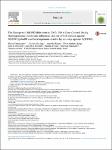The European I-MOVE Multicentre 2013–2014 Case-Control Study. Homogeneous moderate influenza vaccine effectiveness against A(H1N1)pdm09 and heterogenous results by country against A(H3N2)
Valenciano, Marta
Kissling, Esther
Reuss, Annicka
Jiménez-Jorge, Silvia
Horváth, Judit K.
Donnell, Joan M.O.
Pitigoi, Daniela
Machado, Ausenda
Pozo, Francisco
Background: In the first five I-MOVE (Influenza Monitoring Vaccine Effectiveness in Europe) influenza seasons vaccine effectiveness (VE) results were relatively homogenous among participating study sites. In 2013–2014, we undertook a multicentre case-control study based on sentinel practitioner surveillance networks in six European Union (EU) countries to measure 2013–2014 influenza VE against medically-attended influenza-like illness (ILI) laboratory-confirmed as influenza. Influenza A(H3N2) and A(H1N1)pdm09 viruses co-circulated during the season. Methods: Practitioners systematically selected ILI patients to swab within eight days of symptom onset. We compared cases (ILI positive to influenza A(H3N2) or A(H1N1)pdm09) to influenza negative patients. We calculated VE for the two influenza A subtypes and adjusted for potential confounders. We calculated heterogeneity between sites using the I2 index and Cochrane's Q test. If the I2 was 49% we used a two-stage random effects model. Results: We included in the A(H1N1)pdm09 analysis 531 cases and 1712 controls and in the A(H3N2) analysis 623 cases and 1920 controls. For A(H1N1)pdm09, the Q test (p = 0.695) and the I2 index (0%) suggested no heterogeneity of adjusted VE between study sites. Using a one-stage model, the overall pooled adjusted VE against influenza A(H1N1)pdm2009 was 47.5% (95% CI: 16.4–67.0). For A(H3N2), the I2 was 51.5% (p = 0.067). Using a two-stage model for the pooled analysis, the adjusted VE against A(H3N2) was 29.7 (95% CI: −34.4–63.2). Conclusions: The results suggest a moderate 2013–2014 influenza VE against A(H1N1)pdm09 and a low VE against A(H3N2). The A(H3N2) estimates were heterogeneous among study sites. Larger sample sizes by study site are needed to prevent statistical heterogeneity, decrease variability and allow for two-stage pooled VE for all subgroup analyses.
Dateien zu dieser Publikation
Keine Lizenzangabe
Verwandte Publikationen
Anzeige der Publikationen mit ähnlichem Titel, Autor, Urheber und Thema.
-
2016-02-18ZeitschriftenartikelVaccine effectiveness in preventing laboratory-confirmed influenza in primary care patients in a season of co-circulation of influenza A(H1N1)pdm09, B and drifted A(H3N2), I-MOVE Multicentre Case–Control Study, Europe 2014/15 Valenciano, Marta; Kissling, Esther; Reuss, Annicka; Rizzo, C.; Gherasim, A.; Horváth, Judit K.; Domegan, L.; Pitigoi, Daniela; Machado, Ausenda; Bella, A.; Paradowska-Stankiewicz, I.; Larrauri, A.; Ferenczi, A.; O´Donell, Joan; Lazar, M.; Pechirra, P.; Korczyńska, M. R.; Pozo, Francisco; Moren, A.Influenza A(H3N2), A(H1N1)pdm09 and B viruses co-circulated in Europe in 2014/15. We undertook a multicentre case–control study in eight European countries to measure 2014/15 influenza vaccine effectiveness (VE) against ...
-
2011-09-14ZeitschriftenartikelInfluenza B Virus With Modified Hemagglutinin Cleavage Site as a Novel Attenuated Live Vaccine Stech, Jürgen; Garn, Holger; Herwig, Astrid; Stech, Olga; Dauber, Bianca; Wolff, Thorsten; Mettenleiter, Thomas C.; Klenk, Hans-DieterBackground: Both pandemic and interpandemic influenza is associated with high morbidity and mortality worldwide. Seasonal epidemics are caused by both influenza A and B virus strains that cocirculate with varying predominance ...
-
2016-10-13ZeitschriftenartikelImproving influenza virological surveillance in Europe: strain-based reporting of antigenic and genetic characterisation data, 11 European countries, influenza season 2013/14 Broberg, E.; Hungnes, Olav; Schweiger, Brunhilde; Prosenc, Katarina; Daniels, R.; Guiomar, R.; Ikonen, N.; Kossyvakis, A.; Pozo, Francisco; Puzelli, S.; Thomas, I.; Waters, A.; Wiman, Å.; Meijer, AdamInfluenza antigenic and genetic characterisation data are crucial for influenza vaccine composition decision making. Previously, aggregate data were reported to the European Centre for Disease Prevention and Control by ...

